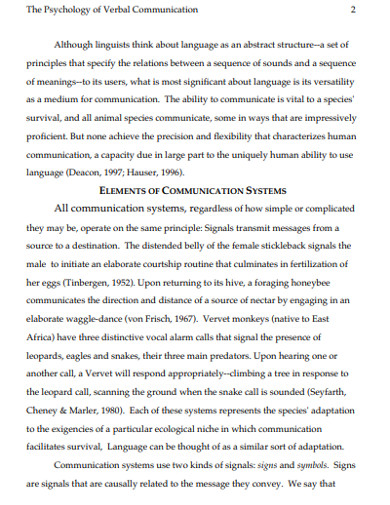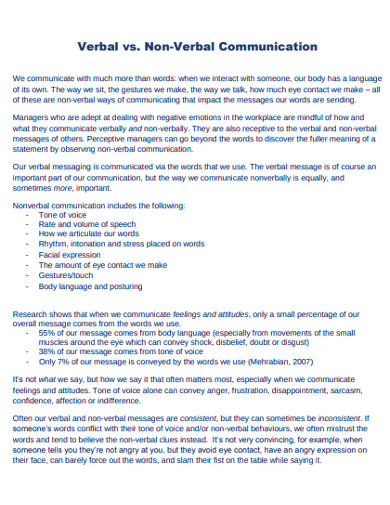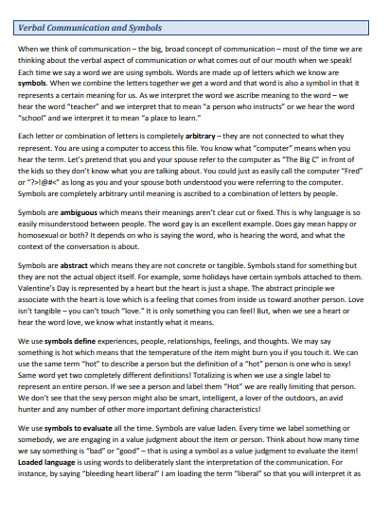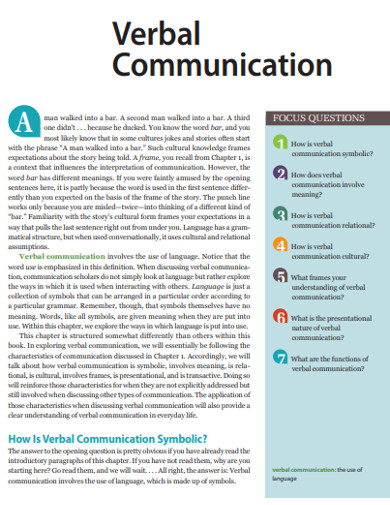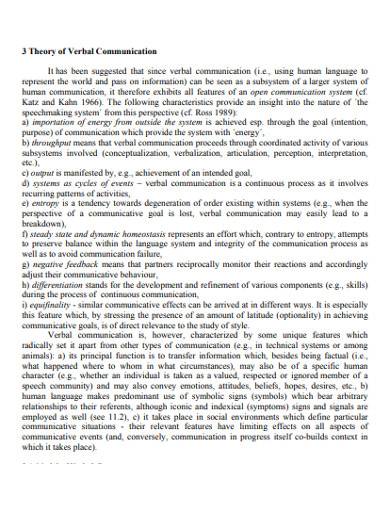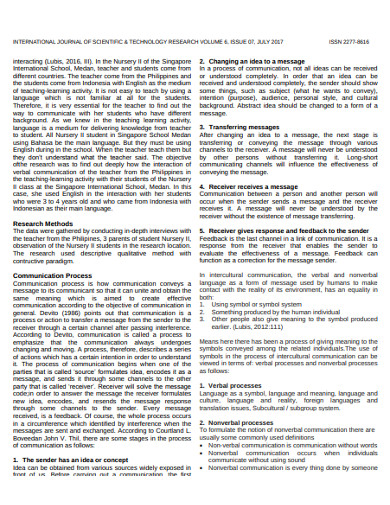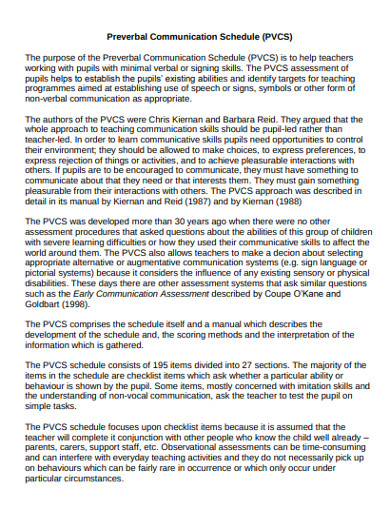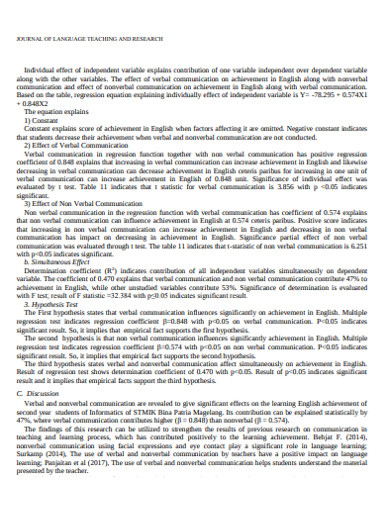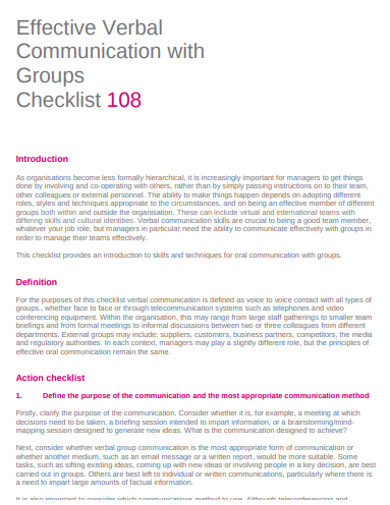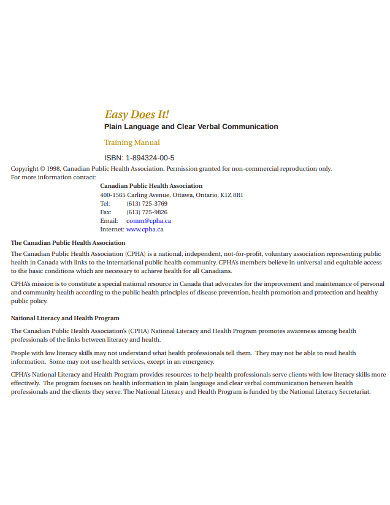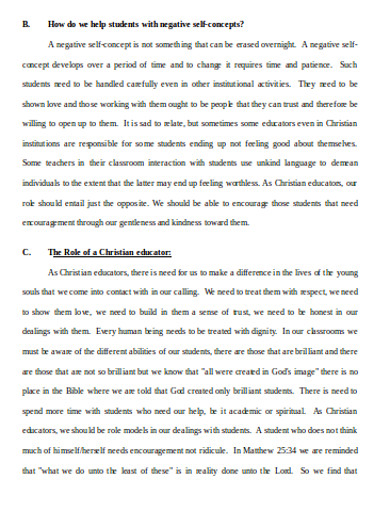100+ Verbal Communication Examples
Master the art of verbal communication with our insightful guide. Learn how to articulate your ideas and emotions with precision, ensuring your words make a lasting impact. Our carefully selected examples and practical tips will empower you to converse with confidence in any scenario, from professional discussions to personal dialogues. Enhance your verbal prowess and open up new avenues for effective and meaningful exchanges.
What is Verbal Communication? – Definition
Verbal communication is the use of spoken words to convey a message. It is a fundamental tool for interaction that allows us to share information, express thoughts and feelings, and connect with others. Verbal communication includes both what is said (the content) and how it is said (the delivery), encompassing tone, pitch, and pace, which can greatly influence the message’s reception.
What is the Best Example of Verbal Communication?
A prime example of verbal communication is a teacher delivering a lesson to students. The teacher uses clear language, adjusts their tone for emphasis, and employs pauses for effect. They might ask questions to gauge understanding and provide feedback based on the students’ responses. This scenario captures the essence of verbal communication: exchanging information in a way that educates, engages, and elicits interaction.
While sound vocalization comes naturally for humans as with most species in the animal kingdom, speech is a skill acquired through extensive learning. Therefore, you can train yourself to become a better speaker in front of anyone. Effective communication skills will take you far in your personal, academic, and professional pursuits.
Verbal communication, unlike nonverbal communication, is the transmission of information through the organized articulation of words. While sound vocalization comes naturally for humans as with most species in the animal kingdom, speech is a skill acquired through extensive learning. Though it is not the only way of communication, we broadcast our thoughts vocally through a known system of language. But because communication is two-way—delivery and reception, it loses its value when the receiver of the information doesn’t understand the message.
100+ Verbal Communication Examples
- Morning Briefings: A manager outlines the day’s goals, highlighting key tasks and offering motivation.
- Customer Service Calls: Representatives address customer concerns with reassurance and provide solutions.
- Parent-Teacher Meetings: Teachers discuss a student’s progress, providing feedback and next steps.
- Doctor-Patient Consultations: Doctors explain diagnoses in understandable terms, ensuring patient comprehension.
- Sales Pitches: Salespeople articulate the benefits of a product, aiming to persuade and close a deal.
- Job Interviews: Candidates articulate their skills and experience while employers ask probing questions to assess fit.
- Political Speeches: Politicians deliver messages aimed at persuading or informing the public on their stances.
- Podcast Hosting: Podcasters use tone and inflection to engage listeners and convey their messages effectively.
- Academic Lectures: Professors impart knowledge using structured verbal explanations to facilitate student learning.
- Legal Arguments: Attorneys present cases to juries, using persuasive language to influence decisions.
- Motivational Speaking: Speakers inspire audiences with powerful words and compelling storytelling techniques.
- Conflict Resolution: Mediators use carefully chosen words to guide disputing parties toward a resolution.
- Comedy Routines: Comedians rely on timing and word choice to deliver jokes and entertain audiences.
- Real Estate Showings: Agents describe properties, emphasizing attractive features to potential buyers.
- News Reporting: Journalists report facts and narratives with clarity and accuracy to inform the public.
- Theater Acting: Actors use dialogue and monologues to portray characters and advance the plot.
- Public Announcements: Information is disseminated to the public through clear and concise spoken messages.
- Training Workshops: Trainers explain concepts and processes, ensuring understanding and practical application.
- Emergency Broadcasting: Clear and direct verbal instructions are given to ensure public safety during emergencies.
- Technical Support: Experts explain complex troubleshooting steps in layman’s terms over the phone.
- Negotiations: Negotiators use strategic language to propose compromises and seal agreements.
- Counseling Sessions: Counselors and therapists use open-ended questions and reflective listening to aid clients.
- Financial Advising: Advisors explain investment strategies and financial concepts to clients.
- Corporate Earnings Calls: Executives summarize financial health and forecasts to investors using industry-specific terminology.
- Parental Guidance: Parents instruct and advise children using age-appropriate language and explanations.
- Team Debriefings: Leaders summarize outcomes of projects or tasks and discuss learnings with the team.
- Teleconferences: Participants share updates and collaborate on projects through group phone calls.
- Religious Sermons: Clergy deliver messages of faith, interpreting religious texts for congregations.
- Tour Guiding: Guides describe historical and cultural significance of sites to visitors.
- Radio DJing: DJs entertain and inform listeners with music, news, and conversation.
- Peer Review Feedback: Colleagues provide constructive criticism and suggestions on work projects.
- Language Classes: Language instructors use target language dialogues to teach students.
- Book Readings: Authors read excerpts from their work, using tone to convey the narrative’s emotion.
- Culinary Classes: Chefs describe cooking techniques and recipes for students to follow.
- Socratic Method in Education: Educators use questioning techniques to encourage critical thinking among students.
- Wedding Vows: Couples express their commitment and love through personalized statements.
- Exit Interviews: Departing employees share their experiences and suggestions for company improvement.
- Customer Feedback: Customers verbalize their satisfaction or issues with a service or product.
- Social Media Live Streams: Influencers engage with their audience in real-time, using spoken language to connect.
- Safety Instructions: Flight attendants provide safety procedures to passengers in a clear, authoritative manner.
- Scientific Conferences: Researchers present findings and engage in discussions about implications and methodologies.
- Business Negotiations: Business leaders discuss terms and conditions, aiming for a mutually beneficial agreement.
- Rally Speeches: Activists inspire action and support for a cause with persuasive language.
- Compliments: Individuals express admiration or praise to others, strengthening social bonds.
- Lifestyle Coaching: Coaches motivate and guide clients to make life changes using positive affirmations and goal-setting discussions.
- Farewell Speeches: Colleagues bid goodbye, recollecting memories and wishing future success.
- Elevator Pitches: Entrepreneurs quickly summarize their business ideas to potential investors or partners.
- Book Clubs: Members share their interpretations and analyses of a book’s themes and characters.
- Travel Booking: Agents discuss itinerary options and details with clients, ensuring their travel preferences are met.
- Panel Discussions: Experts engage in debates and discussions on various topics, providing insights and viewpoints.
- Weather Forecasts: Meteorologists convey weather conditions and forecasts, impacting listeners’ plans.
- Feedback Sessions: Managers give performance feedback to employees to foster professional growth.
- Study Groups: Students discuss material and explain concepts to each other for better understanding.
- Fundraising Appeals: Non-profits articulate the impact of donations during fundraising campaigns.
- Healthcare Directions: Nurses instruct patients on medication schedules and care routines.
- Storytelling for Children: Parents or educators tell stories, enhancing language skills and imagination.
- Therapeutic Exercises: Psychologists walk clients through verbal exercises for mental health improvement.
- Language Interpretation: Interpreters verbally translate speech for audiences or individuals in real-time.
- Crisis Negotiation: Specialists communicate with individuals in crisis to de-escalate situations safely.
- Lyric Writing: Songwriters use lyrics to tell stories and express emotions through music.
- Game Commentating: Commentators describe live sports events, adding excitement for viewers.
- Change Announcements: Company leaders communicate organizational changes to employees clearly and effectively.
- Cultural Explanations: Tourists receive explanations of cultural practices and historical facts from locals.
- Urban Planning Meetings: Planners discuss development projects with community members for feedback.
- Environmental Advocacy: Activists articulate the importance of conservation efforts to the public.
- Workplace Orientation: New employees receive verbal instructions about company policies and culture.
- Debate Competitions: Participants articulate arguments and rebuttals on given topics.
- Art Critiques: Art critics discuss and analyze artworks in galleries or classrooms.
- IT Troubleshooting: Technicians explain problem-solving steps to users experiencing technical issues.
- Volunteer Coordination: Organizers give verbal instructions to volunteers at events or projects.
- Comedy Improvisation: Performers create spontaneous content, engaging audiences with quick wit.
- Surgical Consent: Doctors explain procedures and risks to patients before obtaining verbal consent.
- Emergency Instructions: First responders give clear, authoritative commands during emergencies.
- Conference Keynotes: Speakers deliver insights and trends to audiences at industry events.
- Cultural Sensitivity Training: Trainers discuss ways to respectfully interact with diverse populations.
- Ethical Dilemma Discussions: Groups engage in discussions about hypothetical situations to explore moral decisions.
- Insurance Claims Processing: Agents explain coverage details and claims processes to policyholders.
- Motivational Interviews: Coaches use verbal techniques to encourage clients to discuss their motivation and plans.
- Wine Tasting Descriptions: Sommeliers describe the flavor profiles and origins of different wines.
- Memory Care Activities: Caregivers engage individuals with dementia in reminiscence therapy using verbal prompts.
- Relocation Counseling: Counselors help clients verbalize feelings about moving and adjusting to new environments.
- Grief Counseling: Therapists guide individuals to articulate and process feelings of loss.
- Project Brainstorming: Teams generate and discuss ideas verbally in collaborative sessions.
- Customer Product Reviews: Consumers describe their experiences and opinions about products or services.
- Astronomy Shows: Presenters describe celestial events and constellations at planetarium shows.
- Instructional Design Feedback: Designers discuss user feedback to improve educational materials.
- Retail Sales Pitches: Sales associates highlight product features and benefits to customers.
- Courtroom Testimonies: Witnesses provide verbal accounts of events in legal proceedings.
- Civic Engagement Forums: Citizens articulate concerns and suggestions to local government representatives.
- Speech Therapy Sessions: Therapists work with clients to improve their speech and communication abilities.
- Parenting Classes: Instructors discuss strategies for effective child-rearing and communication with children.
- Social Media Tutorials: Creators explain how to use features and tools in instructional videos.
- Health Awareness Campaigns: Public health officials communicate preventive measures and health information.
- Diplomatic Dialogues: Diplomats engage in delicate discussions to maintain international relations and peace.
- Entrepreneurial Elevator Pitches: Innovators quickly summarize their start-up vision to potential investors.
- Cross-Cultural Training Sessions: Facilitators use verbal exercises to teach effective communication in diverse cultural settings.
- Consumer Negotiations: Shoppers discuss product value and bargain for better prices in various marketplaces.
- University Seminars: Academic experts share research findings and insights in specialized fields of study.
- Language Proficiency Exams: Examinees demonstrate their speaking skills in second language proficiency tests.
- Peer Mentoring: More experienced individuals provide guidance and advice to help others grow personally or professionally.
Verbal Communication Sentence Examples
Elevate your verbal exchanges with our curated sentence examples, designed for effective and impactful communication. Each example is crafted to showcase the power of words in various contexts, helping you to articulate your thoughts with confidence and clarity. From persuasive pitches to heartfelt confessions, our guide ensures your verbal communication is understood and remembered.
- Expressing Concern: “I’ve noticed you’ve been quiet today, is everything okay?”
- Providing Instructions: “Please ensure you back up all your files before the system update at 3 PM.”
- Making Recommendations: “If you enjoyed that book, I think you’d also like this one.”
- Clarifying Misunderstandings: “Just to clarify, our meeting is scheduled for next Wednesday, not Thursday.”
- Setting Expectations: “I expect the report on my desk by Monday morning, without fail.”
Verbal Communication Examples in Everyday Life
Daily life is filled with moments that hinge on verbal communication, from the mundane to the meaningful.
- Ordering Coffee: Articulating your order clearly to the barista to ensure you receive the drink you want.
- Asking for Directions: Politely asking for help to navigate an unfamiliar area.
- Parental Guidance: Parents giving their children instructions for their safety and well-being.
- Social Planning: Discussing and agreeing on plans for a night out or a weekend getaway with friends.
- Customer Inquiries: Asking about a product’s features or availability while shopping.
Verbal Communication Examples in Real Life
Real-life verbal communication is often spontaneous, requiring quick thinking and adaptability.
- Emergency Requests: Seeking immediate help during an urgent situation.
- Job Negotiations: Discussing terms of employment such as salary, benefits, and responsibilities.
- Neighborly Advice: Offering gardening tips or home maintenance suggestions to a neighbor.
- Complaint Resolution: Addressing an issue with a service provider to reach a satisfactory solution.
- Healthcare Discussions: Conversing with healthcare professionals about treatment options.
Verbal Communication Examples in Movies
Cinema often presents heightened examples of verbal communication that capture our imagination and emotions.
- Inspirational Speeches: Characters deliver powerful speeches that move the plot forward or inspire other characters.
- Romantic Declarations: Profound confessions of love that resolve or catalyze a romantic subplot.
- Heated Arguments: Intense exchanges that reveal character flaws or drive home a film’s thematic elements.
- Witty Banter: Quick, playful exchanges that showcase a character’s intellect or charisma.
- Monologues: A character speaks at length, providing insight into their thoughts and motivations.
Verbal Communication Example Situations
Verbal communication is essential in specific scenarios, often dictating the outcome of events.
- Team Leadership: A manager motivates their team with a rallying speech.
- Conflict De-escalation: Calmly talking down a heated situation to prevent further escalation.
- Educational Feedback: A teacher explains a student’s progress and areas for improvement.
- Sales Demonstrations: A detailed explanation of a product’s benefits during a sales pitch.
- Ceremonial Speeches: Speaking at weddings, funerals, or graduations to honor individuals and mark significant life events.
Verbal Communication Examples in Law Enforcement
Precision and authority are the hallmarks of law enforcement verbal communication. Officers must convey commands clearly and manage situations effectively, often under stress. Our examples demonstrate how words can be used to establish control, diffuse tensions, and gather information, all while upholding the law and ensuring public safety.
- Miranda Rights Recitation: “You have the right to remain silent. Anything you say can and will be used against you in a court of law.”
- Witness Interview: “Can you tell me exactly what you saw on the night of the incident?”
- Traffic Stop Instructions: “Please roll down your window and hand me your driver’s license and registration.”
- Crisis Negotiation: “I’m here to help you. Can we talk about what’s bothering you today?”
- Public Safety Announcement: “Please stay indoors until we can ensure the area is safe.”
Verbal Communication Examples in Healthcare
In healthcare, verbal communication can be a lifeline. It’s how caregivers connect with patients, ensure understanding of medical information, and provide comfort. These examples show the importance of empathy, clarity, and sensitivity in healthcare conversations, crucial for patient care and treatment outcomes.
- Patient Diagnosis Explanation: “The test results show that you have a mild case of pneumonia. We’ll start you on antibiotics.”
- Pre-Surgical Briefing: “Before the surgery, we’ll administer anesthesia, which will make you feel very relaxed and sleepy.”
- Post-Operative Care Instructions: “It’s important to keep the wound dry and avoid heavy lifting for at least two weeks.”
- Consoling a Patient: “I know this is a difficult time, but we are going to do everything we can to help you.”
- Discussing Treatment Options: “Let’s go over the benefits and risks of each treatment option to find the best one for you.”
Verbal Communication Examples for Students
Students use verbal communication to explore ideas, express curiosity, and collaborate. The following examples highlight the use of verbal communication in learning environments, fostering engagement, critical thinking, and peer-to-peer learning.
- Asking Clarifying Questions: “Could you explain what the author means by ‘circular reasoning’?”
- Participating in Class Discussions: “In my opinion, renewable energy is the key to sustainable development.”
- Group Project Coordination: “Let’s divide the tasks based on our strengths; I can take care of the research part.”
- Peer Tutoring: “Remember, to solve for x, you first need to isolate the variable on one side.”
- Presenting a Book Report: “The main theme of the book revolves around the struggle between freedom and control.”
Verbal Communication Examples in the Classroom
The classroom is an epicenter of verbal learning and teaching. Educators and students alike rely on verbal communication to navigate the educational journey, as shown in these examples.
- Instructing a Class: “Today, we’ll learn about photosynthesis, the process by which plants make their food.”
- Debating a Topic: “Let’s discuss the pros and cons of social media for teenagers in today’s society.”
- Explaining a Concept: “A metaphor is a figure of speech where you describe an object by comparing it to another.”
- Answering Questions: “The capital of France is Paris, which is also known as the ‘City of Light’.”
- Facilitating Group Work: “I want each group to come up with three hypotheses based on the experiment’s outcome.”
Verbal Communication Examples for Teachers
Teachers are verbal communicators by profession, whether they’re providing knowledge, giving feedback, or encouraging students. These examples emphasize the role of clear and impactful verbal communication in the educational development of students.
- Directing Classroom Activity: “Please turn to page 42, we’ll start by reading the first two paragraphs together.
- Feedback on Assignments: “You’ve done an excellent job researching for this paper, but I’d like to see more analysis in your next assignment.”
- Encouragement to Participate: “I appreciate your perspective, Maria. Does anyone else have thoughts on this topic?”
- Clarifying Instructions: “Make sure to cite at least three sources in your essay, and remember that Wikipedia isn’t an acceptable source.”
- Managing the Classroom: “Before we dismiss, please make sure your work areas are clean and your chairs are pushed in.”
Verbal Communication Examples in the Workplace
Foster a thriving professional environment with effective verbal communication in the workplace. From clear directives to collaborative team discussions, our guide covers essential workplace phrases that facilitate cooperation, enhance clarity, and promote a positive work culture. Master these examples to lead with confidence, resolve workplace conflicts, and build strong, productive teams.
- Project Kick-off: “We’re launching an exciting project this quarter, and I’m confident that with everyone’s expertise, we will exceed our goals.”
- Performance Review: “You’ve made impressive progress this quarter, particularly in client relations, which has led to an increase in customer satisfaction.”
- Delegating Tasks: “John, could you take the lead on the market analysis? Your analytical skills will be perfect for this task.”
- Handling Conflicts: “I’ve noticed some tension in the team dynamics. Let’s sit down together and talk through the challenges everyone is facing.”
- Announcing Changes: “Starting next month, we’ll be implementing a new system to streamline our workflow and improve efficiency.”
Positive Verbal Communication Examples
Positive verbal communication is a catalyst for motivation, engagement, and relationship building. These examples are designed to promote a supportive atmosphere, whether you’re giving praise, offering encouragement, or expressing gratitude. Use them to uplift those around you and create an environment where positive communication paves the way for mutual respect and success.
- Expressing Appreciation: “Your dedication to this project truly made a difference in its success. Thank you for your hard work.”
- Offering Encouragement: “I know this task is challenging, but I’ve seen your skills, and I believe you have what it takes to tackle it.”
- Celebrating Achievements: “Congratulations on reaching your sales target this month, Emily! Your strategy was innovative and effective.”
- Providing Supportive Feedback: “This is a strong start to your presentation, and with a few more data points, I think it will be even more compelling.”
- Encouraging Team Spirit: “When we work together and openly share our ideas, there’s no problem we can’t solve as a team.”
Sound vs. Speech
Sound is intrinsic in animals. Animals vocalize to communicate information to their kind or to other animals in a system that the receiver also understands. Birds sing when they are looking for potential mates. But they are calling each other for the rest of the year to call their kind or warn of danger. Rattlesnakes shake the tip of their tail to warn others to stay away or be bitten. The sound seems to do its job, and an owl is taking notice. When a burrowing owl hisses, it sounds like that of the rattlesnake’s rattle. The sound keeps others from disturbing the bird’s peace.
What’s fascinating is that animals can produce sounds unique to their species even if they were isolated. Although humans can produce sounds after birth, we can’t transmit intelligible information before we are trained to do so. Based on research on language acquisition performed on children born deaf, we have to receive such training early in life to be able to speak the way we do. Hearing sounds is important in learning to speak and refining speech. Those whose hearing was impaired had difficulty learning to speak. While the children whose hearing ability was impaired later in life showed problems in their speaking skills.
10+ Verbal Communication Examples
Browse through the following verbal communication examples.
1. Psychology of Verbal Communication Example
2. Sample Verbal Communication Example
3. Sample Verbal Communication Example
4. Basic Verbal Communication Example
5. Theory of Verbal Communication Example
6. Interaction Of Verbal Communication Example
7. Preverbal Communication Schedule Example
8. Teachers Verbal Communications Example
9. Verbal Communication with Group Checklist Example
10. Verbal Language Communication Example
11. Verbal Class Room Communication Example
Is Communication Verbal or Non-Verbal?
Communication is both verbal and non-verbal. Verbal communication involves the use of spoken or written language to convey a message. It is direct and explicit, using words to express ideas, thoughts, and emotions. Non-verbal communication, on the other hand, includes body language, facial expressions, tone of voice, gestures, posture, and eye contact, which can often convey more than the spoken word. Both forms are integral to effective communication and often occur simultaneously, complementing and influencing each other.
What is Verbal and Nonverbal Communication with Examples?
Verbal communication is when information is expressed through words, whether it’s spoken dialogue or written text. For instance, a manager providing feedback during a performance review or a poet reciting a piece are examples of verbal communication. Non-verbal communication is the silent language of gestures and expressions. A thumbs-up for a job well done, maintaining eye contact to show interest, or a slumped posture indicating disappointment are all non-verbal cues that add depth to the spoken word.
Verbal Communication Techniques
Effective verbal communication techniques are essential for conveying messages clearly and ensuring they are received as intended. Here are some strategies:
- Clarity and Brevity: Use clear, concise language to ensure your message is easily understood. Avoid jargon and overly complex sentences.
- Tone and Inflection: Vary your tone to emphasize important points and keep your audience engaged. Your inflection can convey your emotional response to the content.
- Active Listening: Engage with the speaker, show that you understand, and provide feedback when appropriate.
- Effective Pausing: Use pauses to give emphasis, allow absorption of information, and control the pace of your speech.
- Empathetic Language: Choose words that show understanding and respect for the listener’s perspective.
- Storytelling: Utilize narratives to make your communication more engaging and memorable.
- Repetition for Emphasis: Repeat key points to reinforce them in the listener’s mind.
- Asking Questions: Use open-ended questions to encourage discussion and closed-ended questions to gain specific information.
- Adaptability: Tailor your speech to your audience, considering factors such as their knowledge level and cultural background.
- Positive Language: Frame your messages positively when possible to create a constructive atmosphere.
Verbal Communication Benefits
Verbal communication stands as a pillar of human interaction, offering numerous benefits that facilitate personal connections and professional success:
- Clarity and Precision: Verbal communication allows for the expression of thoughts and ideas with clarity and precision, reducing the likelihood of misunderstandings.
- Immediate Feedback: It enables immediate feedback, allowing for quick clarification and discussion, which is essential in fast-paced environments.
- Emotional Expression: Verbal cues provide a platform for emotional expression, helping speakers convey feelings and listeners interpret sentiments.
- Persuasion and Influence: Skillful verbal communication can persuade and influence others, making it a powerful tool in negotiations and leadership.
- Building Relationships: Conversations foster rapport and trust, building stronger personal and professional relationships.
- Educational Tool: Verbal communication is fundamental in education, allowing for the effective transfer of knowledge between teachers and students.
- Cultural Exchange: It facilitates cultural exchange, enhancing understanding and appreciation of diverse perspectives.
- Conflict Resolution: Speaking and listening are key in resolving conflicts, providing a means to reach mutual understanding and agreement.
- Enhanced Professional Image: Articulate verbal communication can enhance one’s professional image, projecting confidence and competence.
- Inclusivity: Verbal communication can be inclusive, offering ways to adapt language to ensure everyone in a diverse audience can understand and engage.
Verbal Communication Function
The function of verbal communication extends beyond the mere exchange of information; it serves several vital roles in daily interactions:
- Information Dissemination: At its core, verbal communication disseminates information quickly and efficiently.
- Regulation/Control: It regulates behaviors, giving instructions, orders, and directions that guide others’ actions.
- Social Interaction: Verbal exchanges facilitate social interactions, playing a critical role in forming bonds and socializing within a community.
- Motivation: Encouraging words can motivate and inspire individuals to take action or persist in their efforts.
- Emotional Sharing: Sharing thoughts and emotions verbally can provide comfort, create intimacy, and build empathy among individuals.
- Expression of Identity: Through language choice, storytelling, and personal narratives, individuals express their identities and connect with like-minded others.
- Decision-Making: Group discussions and deliberations rely on verbal communication to weigh options and make collective decisions.
- Problem-Solving: Verbalizing problems and discussing potential solutions are central to collaborative problem-solving efforts.
- Persuasion: Convincing others of a particular viewpoint or action is often achieved through persuasive verbal communication.
- Entertainment: Finally, verbal communication entertains, whether through jokes, storytelling, or engaging dialogues that captivate an audience’s attention.
What are Elements of Verbal Communication?
Verbal communication is an intricate interplay of various elements that contribute to the effectiveness of a message:
- Language: The choice of words and the structure of sentences, which vary across different languages and dialects.
- Tone: The modulation of the voice that conveys the speaker’s attitude or feelings towards the subject or the listener.
- Pitch: The highness or lowness of the voice, which can emphasize points and convey different meanings.
- Volume: The loudness or softness of the voice, which can indicate the level of emotion or the importance of the message.
- Rate: The speed at which one speaks; a rapid rate can convey excitement, while a slower rate can emphasize importance or allow for clarity.
- Clarity: The clear articulation of words, ensuring that the message is understandable to the listener.
- Fluency: The smoothness of speech, which facilitates ease of communication and listener engagement.
- Enunciation: The distinctness with which sounds are made; precise enunciation helps prevent miscommunication.
- Choice of Words: Selecting words that best fit the context and audience understanding, including the use of jargon, technical terms, or colloquial language.
- The Silence and Pauses: Strategic use of silence and pauses can provide emphasis, allow for reflection, or serve as non-verbal cues within communication.
What are the Characteristics of Verbal Communication
Verbal communication is characterized by its unique properties that differentiate it from non-verbal forms of communication:
- Symbolic: Verbal communication uses words as symbols that represent something else, allowing for the expression of abstract ideas.
- Conventional: It relies on language conventions or agreed-upon rules, which means that words have specific meanings understood by those who share the language.
- Dynamic: The use of language evolves over time, reflecting changes in culture and society.
- Interactive: Verbal communication is inherently interactive, often occurring in a back-and-forth manner with an exchange of messages between speaker and listener.
- Cultural: It is influenced by cultural norms and practices, which dictate what is appropriate to say and how to say it in different contexts.
- Contextual: The meaning of verbal communication can change depending on the context in which it occurs, including the physical setting, the relationship between communicators, and the purpose of the interaction.
- Personal: Verbal communication allows for personal expression and the sharing of individual thoughts and emotions.
- Subjective: The interpretation of verbal messages can be subjective, influenced by an individual’s experiences, beliefs, and attitudes.
- Sequential: It has a clear sequence, with a beginning, middle, and end, which helps to structure communication and make it coherent.
- Learned: Unlike some forms of non-verbal communication, verbal communication is a learned behavior that we acquire from observing and imitating others.
Advantages and Disadvantages of Verbal Communication
Below is a table that outlines the advantages and disadvantages of verbal communication, providing insights into when and how verbal communication can be most effectively utilized and the potential pitfalls to be aware of.
| Advantages of Verbal Communication | Disadvantages of Verbal Communication |
|---|---|
| Clear and Direct: Verbal communication allows for the explicit expression of ideas and concepts, leading to immediate understanding. | Misinterpretations: Words can be misunderstood, especially if the listener and speaker have different interpretations of the language used. |
| Quick Feedback: It enables instant feedback, allowing for swift clarification and ongoing dialogue. | Lacks Non-Verbal Cues: In situations like phone calls, the absence of body language can lead to loss of depth and meaning. |
| Personal Touch: The use of voice can convey warmth, sincerity, and a personal touch, which can be particularly persuasive. | Language Barriers: Effective verbal communication is hindered when the parties do not share the same language fluently. |
| Adaptability: Speakers can adjust their tone, pace, and vocabulary on the spot to suit the audience and context. | No Permanent Record: Unless recorded, verbal communication doesn’t provide a tangible record, which can be a disadvantage for recalling details later. |
| Ease of Use: Speaking is a natural ability and often the quickest way to exchange information. | Emotional Misinterpretation: Tone can be misconstrued, leading to emotional responses that may not align with the speaker’s intent. |
| Efficient for Group Communication: Verbal communication is effective for group discussions and brainstorming sessions. | Overwhelming Information: Too much information delivered verbally can overwhelm the listener and lead to information overload. |
| Demonstrates Speaker’s Personality: The speaker’s style can add an extra layer of meaning to the content of the message. | Physical Presence Required: In most cases, effective verbal communication requires the speaker and listener to be physically present, which can be limiting. |
| Can Be Persuasive: Good verbal communication skills can influence and motivate others. | Distractions: Environmental noise and distractions can disrupt the flow of verbal communication. |
| Facilitates Emotional Connection: It can build and maintain relationships through emotional exchanges. | Cultural Differences: Cultural misunderstandings can arise from different uses and interpretations of language. |
| Expressiveness: Allows for a range of emotions and nuances through changes in voice |
Types of Verbal Communication
Small group communication: This is similar to a conversational type of communication shared between a small number of people. There can be more than one person talking during this interaction. Examples of this type of interaction are workplace meetings and press conferences.
Interpersonal communication: Interpersonal communication is the conversation that occurs between two or more individuals wherein they share information one at a time. One person sends the information and another or a group of people process and interprets it.
Intrapersonal communication: The conversations you host in your head is an example of intrapersonal communication. This form of communication exists within ourselves as we send and interpret the same information.
Public communication: Public speakers address a large group of people. They either prepare a speech or a script or talk in impromptu. There is one person talking and the rest of the crowd listens to what he or she has to say.
How To Communicate Effectively
It should be one of your goals to develop your communication skills, either for business or leisure. When addressing a person or a group of people, how do you effectively and efficiently deliver your message as you have organized it in your head?
1. Take Short Pauses
When you’re preparing a speech, make an outline that you picture in your head as you are speaking. But don’t hurry to get to the end of that outline. Take your time by taking short pauses. The breaks will help you organize your thoughts and think about the words that will come out of you. When you’re on stage, a short water break will help you arrange your ideas in your head. Speak in such a way that each word uttered clearly.
2. Adjust Volume and Tone
You don’t speak as loud when you are talking face to face with someone as you would when speaking in front of a crowd. Adjust the volume of your speaking voice, especially when a microphone isn’t available. You should also vary your voice tone so as to avoid monotone in your speech. Rich tones and inflection will help you emphasize key points in your message. An animated speaking voice also engages the audience and keeps them hooked to what you’re saying.
3. Mind Your Body Language
Whether you are talking to someone in private or in front of a large crowd, your nonverbal language plays a role in delivering your message as you intended it. You can use gestures but keep it appropriate and minimal so that they don’t distract the listeners. Your facial expressions will also help you convey the meaning of your message. Body language will enhance or change the audience’s interpretation of what you are saying.
4. Own Your Words
Be confident in your skills and ability to address the people you are talking to. Self-doubts about your skills will only distract you from delivering your message effectively. Confidence exudes from your posture, body language, and voice. Command the attention of the room by refining these factors. You can’t convince a crowd when you can’t even convince yourself. Start learning how to deliver persuasive speeches today!
Speaking effectively is an art that most people fail to see the benefits of until it’s late. Make it a self-improvement goal for the year to become a better, effective, and persuasive speaker. By diligently practicing, you will conquer communication barriers and the fears you have with public speaking.
How to Improve Verbal Communication
Improving verbal communication is essential for fostering effective and enriching interactions. Here’s a guide to enhancing your verbal skills:
- Expand Your Vocabulary: A rich vocabulary allows for more precise and varied expression of thoughts.
- Read Widely: Reading books, articles, and other materials can introduce you to new ideas and ways of phrasing.
- Engage in Public Speaking: Practice speaking in front of groups to gain confidence and refine your delivery.
- Listen Actively: Good communicators are also attentive listeners. Listen to understand, not just to respond.
- Think Before You Speak: Organize your thoughts to communicate more coherently and avoid miscommunication.
- Seek Feedback: Encourage others to provide constructive feedback on your verbal communication.
- Participate in Discussions: Join debate clubs or discussion groups to practice articulating your thoughts clearly.
- Take Communication Courses: Formal education in communication can provide valuable techniques and practice.
- Record and Review: Record your speech to identify areas for improvement, such as filler words or clarity.
- Practice Empathy: Tailor your language to your audience by considering their feelings and perspectives.
Tips for Using Verbal Communication
Here are some tips to make the most out of your verbal interactions:
- Be Clear and Concise: Aim for simplicity. Clear and concise messages are more likely to be understood.
- Use Positive Language: Positive phrasing can improve the tone of conversations and the receptiveness of your audience.
- Adjust Your Pace: Speak neither too fast nor too slow. A moderate pace aids understanding.
- Employ Pauses: Use pauses to emphasize points and to give listeners time to process information.
- Mind Your Tone: Your tone should match the content of your message and the context of the conversation.
- Be Mindful of Non-Verbal Cues: Your body language should support and not contradict your words.
- Be Authentic: Authenticity in communication fosters trust and credibility.
- Use Stories and Examples: Illustrative stories and examples can make your message more relatable and memorable.
- Be Culturally Sensitive: Be aware of cultural differences that may affect how your message is received.
- Practice Regularly: Like any skill, verbal communication improves with regular practice.



